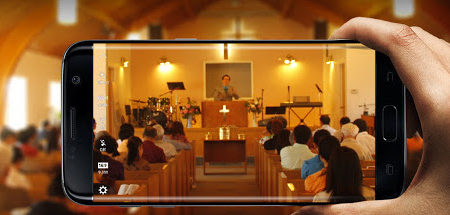Livestreaming and child safety
Though social distancing and lockdown seem like a distant memory, things like livestreaming our church gatherings have remained a valuable tool for community and connection. Because communities are still engaging in these digital practices, it is important that we continue to review what it means to be a safe community for children and vulnerable adults. So, what does it mean to maintain safe livestreaming practices for all our members of community, particularly when it comes to vulnerable individuals, children on screen, and the sharing of confidential information during public prayer requests.
Here are five do’s and don’ts to ensure the safety and wellbeing of all those involved:
Clearly label and address areas on camera
Before livestreaming any gathering or event, it is important to have clear communication about when and where a camera will be recording and sharing information. This can include clearly marking out, perhaps with tape along the ground/signs on the walls/a note in the newssheet and pews, the area(s) the camera can reach. This is a crucial step for the wellbeing of vulnerable populations such as minors, elderly individuals, or those of differing abilities. By communicating and clearly marking out these areas we maintain the respect for people’s privacy and their comfort levels of participation. By being transparent with this information, we give parents, carers, and guardians the best chance to opt out of being on camera if required.
Do ensure consent and privacy for those under 18
If under-18-year-old members of the community are regularly involved in activities that appear on camera, it is crucial to gain parent/guardian permission beforehand. By gaining media permission and having a well-signed area of where one might appear on screen, we give parents/guardians the required information to make informed decisions regarding their child’s digital safety. Our communities are responsible for adhering to child protection policies, and this includes children’s safety in the digital world.
If your community culture involves children being able to wander freely, sometimes in and out of the camera frame, make sure that you communicate directly with the parents, guardians and careers what area(s) the camera can reach. Having signs up is a helpful reminder, however, the best way to maintain digital safety is having transparent and communicated information.
Don’t share identifying information
If you’re livestreaming it is important to avoid sharing personal or identifying information about individuals during your gatherings. This includes full names, addresses, phone numbers, or sensitive information that can identify an individual and compromise their safety and privacy. When discussing prayer requests and sharing testimonials, use discretion and refrain from sharing unnecessary details. If your community culture involves an open-mic opportunity during the prayers, please ensure that your community maintains each other’s privacy: it could be advantageous to pause the livestream so prayer requests can be shared freely. While it is important to support and uplift community members in prayer, it may be best to encourage individuals to share prayer requests in a secure and confidential manner offline.
Do monitor and moderate your online interactions
Assign trained leaders to monitor, and have administration access to, the livestream chat and comments during the recording and at regular intervals into the future for people who may have engaged in the chat later. The digital space also requires assigned and Safe Church-trained leaders to maintain a safe digital environment so they’re able to limit and remove any inappropriate or harmful content.
Make sure to foster a culture of accountability and support
Encourage open communication and accountability within your community regarding online and digital safety. Make sure that you have open channels for people to report any concerns related to livestreaming and online interactions and take appropriate action to address them in a timely manner. This also includes having shared and accessible online community guidelines for those who are engaging in your gatherings digitally. Guidelines help people to know appropriate and inappropriate behaviour, as well as keeps people accountable for their actions.
In conclusion, livestreaming can be a valuable tool for faith communities to stay connected and engaged, but it’s essential to prioritise safety and privacy at all times. By implementing clear guidelines, respecting consent and privacy, and fostering a culture of accountability, we can continue to create safe and supportive digital environments for all participants.





